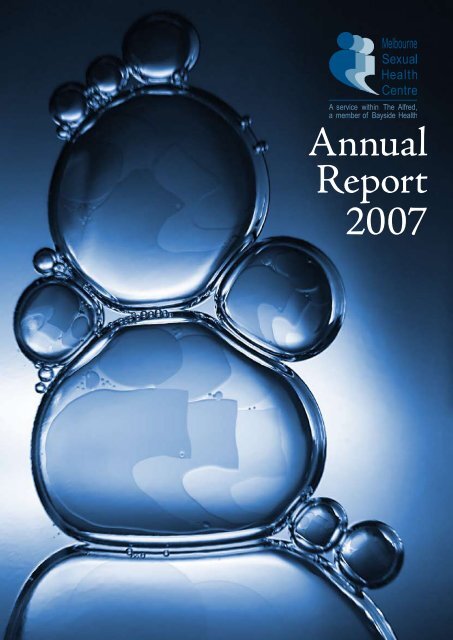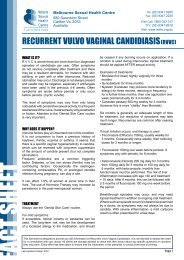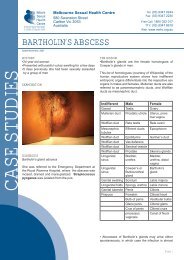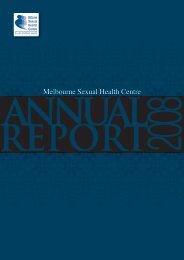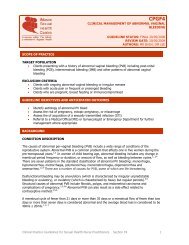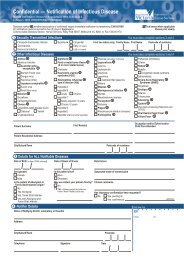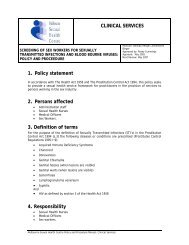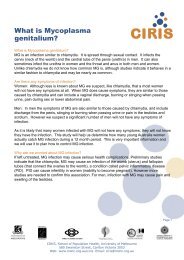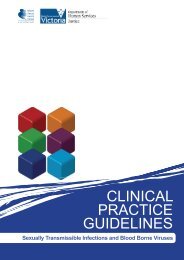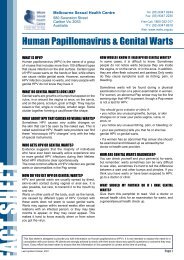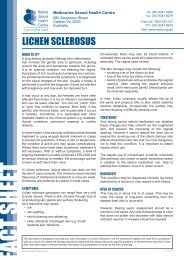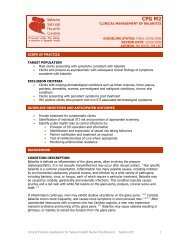Annual Report 2007 - Melbourne Sexual Health Centre
Annual Report 2007 - Melbourne Sexual Health Centre
Annual Report 2007 - Melbourne Sexual Health Centre
You also want an ePaper? Increase the reach of your titles
YUMPU automatically turns print PDFs into web optimized ePapers that Google loves.
<strong>Annual</strong><strong>Report</strong><strong>2007</strong>
<strong>Melbourne</strong> <strong>Sexual</strong> <strong>Health</strong> <strong>Centre</strong> (MSHC)is a service within Bayside <strong>Health</strong>. The vision of MSHC is to be a leader in themanagement and prevention of <strong>Sexual</strong>ly Transmissible Infections (STIs) and itsmission is to maximize sexual health through innovation and excellence in publichealth, education, clinical care and research.CONTENTSOVERVIEW 4DIRECTOR’S REPORT 5SERVICES AND CONSULTATIONS 6DIAGNOSES 6OUTREACH SERVICES 9RESEARCH 10PUBLICATIONS in <strong>2007</strong> 13STAFF 14Addendum: Client Satisfaction Survey
OVERVIEWThe MSHC has been in operation since 1917 as aspecialised unit for the diagnosis and treatment of sexuallytransmissible infections (STIs). It is the only centre thatprovides full-time, free sexual health services to thepeople of Victoria. The <strong>Centre</strong>’s funding is assured underan agreement between the Commonwealth and StateGovernment. The services provided by MSHC includegeneral clinics for the management of STIs and a varietyof specialist clinics.The team of health care providers at MSHC includes26 doctors, 34 sexual health nurses, 2 counsellors, anda dietitian. The clinicians play an instrumental role inscreening and testing for STIs, STI prevention, educationand counselling. The health care team is supported by 17other staff members in administrative or clerical roles, ITsupport, 2 pharmacists and 3 medical scientists.As rates of STIs have increased in Victoria, so too hasdemand for the <strong>Centre</strong>’s services. MSHC has continuedto place importance on the provision of services thatmaximise access for members of the public. This hasbeen achieved through the continued provision of servicesthat are free of charge, have greater flexibility through theuse of walk-in triage and additional gains from clinicalefficiency. This will be further enhanced by the introductionof extra clinical services targeting men who have sex withmen (MSM), who currently constitute a major risk groupfor STIs in Victoria.One of MSHC’s key roles is to promote public healthand education. It aims to provide material that is freelyavailable to both the general public and health careproviders, particularly general practitioners (GPs).MSHC provides support to GPs as well as the publicthrough its recently updated web based services (www.mshc.org.au) and a free-call telephone service wherebyGPs can receive specialist clinical advice directly froma sexual health physician. The <strong>Centre</strong> also fulfils animportant role as a principal centre for the training ofhealth professionals in Victoria.The <strong>Sexual</strong> <strong>Health</strong> Unit of the University of <strong>Melbourne</strong>is situated at MSHC and conducts epidemiological,public health and clinical research aimed at improvingthe services offered at MSHC and public health morebroadly. In collaboration with the School of Population<strong>Health</strong> the <strong>Centre</strong> offers a number of postgraduatecourses, postgraduate subjects and short courses insexual health.MSHC places a premium on the provision of high qualityservices that are responsive to client needs. To this end,the <strong>Centre</strong> is active in quality assurance activities, whichinclude an annual client satisfaction survey, where 98%of clients have consistently expressed satisifaction withthe service.Special services provided by MSHC:4• Medical care and community welfare support forpeople living with HIV• Colposcopy clinic for women with abnormal Pap tests• Vulval clinic for medical assessment and managementof women with vulval disorders• Dermatology clinic for specialist dermatologicalmanagement of genital skin disorders anddermatological conditions in HIV positive and negativeclients• Counselling services with qualified counsellors thatare available for individuals or couples withconcerns about sexual health and STIs, including HIV• Outreach services for street based sex workers andmen who attend sex on premises venues• On-site pharmacy• On-site laboratory service provided by the Public<strong>Health</strong> Laboratory - Microbiology Diagnostic Unit(PHL-MDU), University of <strong>Melbourne</strong> whichprovides assistance to clinicians to make sameday diagnoses and treatment
DIRECTOR’S REPORTWelcome to our <strong>2007</strong> annual report. We are veryfortunate to have an enormous depth of highly trainedand committed staff. For the forth year in a row we haveachieved outstanding results in our client satisfactionsurvey which fundamentally is a refection of our staff whohave yet again performed brilliantly. An added bonus wasthe staff survey which showed overwhelmingly that stafflike working here and providing an exceptional clinicalservice under considerable strain.The <strong>Centre</strong> also appreciates the importance of improvingSTI services throughout the state in addition to providingexcellent on site clinical services. In <strong>2007</strong> we made anumber of important additions to our IT services tostrengthen our support to the Victorian community.Welaunched the GPassist component of the web site (www.mshc.org.au/GPassist) which was a culmination of DrTomnay’s PhD studies. Our superb IT team captured theresearch findings and developed the GP assist web sitethat provides contact letters, treatment guidelines andclient brochures for all common STIs. Most laboratoryservices in <strong>Melbourne</strong> provide a link to this site on theirreports of positive test results for STIs. This providesGPs with immediate access to these tools at the exactmoment that they are seeing the client. The researchdemonstrated that GPs found the documents to be ofpractical value and were commonly used when providedin this way. In recognition for her contribution and thatof the IT team, the <strong>Centre</strong> received the <strong>2007</strong> Victorian<strong>Health</strong>care Award in the category of IT innovation.In <strong>2007</strong> we were also extremely pleased to launch ourcompletely rebuilt web page. After many long hoursand extraordinary efforts, our staff have created anoutstanding web page. It provides strong support topractitioners outside the centre with clinical photographs,case studies, videos of common procedures, treatmentguidelines and many other highly innovative onlinefeatures. It represents the culmination of the work ofmany highly dedicated, resourceful and imaginativeindividuals who have a common focus on improving thesexual health of Victorians. There is also an interactiveonline service for members of the public (Check your Risk:www.checkyourrisk.org.au), which enables individualsto receive automated online recommendations for STIscreeningMSHC continues to be one of Australia’s powerhousesfor STI research. This is in no small way a result of theenormous support provided by the <strong>Centre</strong>’s dedicatedclinical, IT and administrative workforce who provideunending support for innovation. In <strong>2007</strong> the <strong>Centre</strong>published more than 20 scientific articles and had fourresearch students complete their theses including threedoctoral students. The work these individuals undertookwas not ivory tower academic material, but has laid thefoundations for continued innervations in the provision ofservice excellence.Dr Tideman’s thesis for example has provided thenecessary data to allow the implementation in 2008 ofcomputer assisted interviewing that will both increase theefficiency and quality of the service the <strong>Centre</strong> provideswhile Dr Sidat’s work has improved the provision of HIVservices through the development of “<strong>Health</strong> Map” toassist clients with HIV (www.healthmap.org.au).The <strong>Centre</strong> and its staff received a number of importantawards in <strong>2007</strong>. Dr Bradshaw was the recipient of oneof four highly prestigous L’Oreal For Women in Sciencefellowships. The <strong>Centre</strong>’s HIV service received theVictorian AIDS Councils Presidents award and the GPassist program the <strong>2007</strong> Victorian <strong>Health</strong>care Award forIT innovation. These awards highlight two things. Firstlythe calibre and commitment of the individuals who workat the <strong>Centre</strong> and secondly the <strong>Centre</strong>’s constant drivefor innovation to improve the efficiency and quality of theservice it provides. A clinical service that does not focuson improving, effectively moves slowly backwards.This year we celebrated the enormous contribution ofNilofar Rizvi, who after nearly three decades of dedicatedservice retired. We all have very fond memories of hertime at the centre and I in particular am grateful to her forher support since 2001 when I started.None of what we have achieved would be possiblewithout our staff. These individuals perform at a simplyastounding standard as evidenced by some of ourachievements above. I am immensely grateful to eachand every one of them, and to the Victorian Departmentof Human Services who fund this service, and to Bayside<strong>Health</strong> whose support, year after year allows us to makethe contribution we do, to the health of our Victoriancommunity who we serve.5
SERVICES AND CONSULTATIONSThe <strong>Centre</strong> has provided high quality care for clients with a total of 27,457 consultations and 9,962 new clients beingregistered in <strong>2007</strong>. The walk-in triage system remains a catalyst for prioritizing high risk and symptomatic clients with90% of clients being assessed by a triage nurse in less than 20 minutes and being seen by a practitioner within one hour.This compares favourably with the previous appointments based service.The numbers of consultations provided by MSHC according to type of service and sex of the client are shown in the tablebelow. A further 506 offsite consultations occurred at various outreach venues for MSM and street sex workers (SSW).Clinic Type Total Male Female TransgenderGeneral Clinic 23,744 13,446 10,265 33HIV Clinic 1,557 1,390 165 2Outreach 407 357 49 1Counselling 932 700 231 1Vaccination 817 565 252 -Total 27,457 16,458 10,962 37Individuals 16,877 9,962 6,891 24DIAGNOSESThe numbers of the most frequently made diagnoses at MSHC are shown in the table below.DiagnosesTotalChlamydia trachomatis 721Neisseria gonorrhoeae 204Nongonococcal urethritis 781Herpes simplex virus 786Syphilis 93Bacterial vaginosis 518Warts 1611Human immunodeficiency virus (new cases) 42HIV post exposure prophylaxis 190Post coital contraception 83Trichomoniasis in women 106
Chlamydia trachomatis remains the most common bacterial STI diagnosed at MSHC.The number of chlamydia infections by sex and site are shown below.Males - Chlamydia by site <strong>2007</strong>(YTD = 480)45403530252029343632342120 2026282322FPUAnUrFPU/AnAn/UrTh151050151412111110978736 653 343 322 22 11 1 1 1JAN FEB MAR APR MAY JUN JUL AUG SEP OCT NOV DECList of abbreviations: FPU – first pass urine; An – anal; Ur – urethral, Th - throat25Females - Chlamydia by site <strong>2007</strong>(YTD = 241)2015101618 18128 82013121110 10 10CxFPUHVSAnCx/FPUCx/An5066 65 5 5 544 43 3 33321 1 1 1 1 1 1 1JAN FEB MAR APR MAY JUN JUL AUG SEP OCT NOV DECList of abbreviations: Cx – cervical; HVS – high vaginal7
The majority of gonococcal infections occur in MSM.Males - Gono by site <strong>2007</strong>(YTD = 192)1211 1110Ur9 9 9An864876 6 6 655 5 544 43 3 3 3 3387ThAn/UrAn/ThUr/ThFPUUr/Th/An202 2 22 2 2 2 2 2 211 1 1 1 11 11 1 1 1 11 11 1 1 1JAN FEB MAR APR MAY JUN JUL AUG SEP OCT NOV DECFemales - Gono by site <strong>2007</strong>(YTD = 12)2.521.5121 1 1 1 1 1 1 1 1 1CxThCx/ThHVSCx/Th/AnCx/Ur0.50JAN FEB MAR APR MAY JUN JUL AUG SEP OCT NOV DEC8
OUTREACH SERVICESIn <strong>2007</strong>, 9 nurses were engaged in outreach work, providing STI/BBV screening for higher risk communities such asmen who access Sex-on-Premises Venues (SOPVs) and street based sex workers. A total of 506 offsite consultationswere conducted for 415 males, 88 females and 3 transgender clients.Sex on Premises VenuesOur outreach team continued weekly or second weekly visitsto six SOPVs in <strong>Melbourne</strong> where confidential STI testing wasprovided for MSM.There were 395 consultations performed for 258 individualclients with 182 new clients registered for this service during<strong>2007</strong>. The service has been well received by clients andsupported by venue proprietors. With additional funding fromthe Victorian Department of Human Services, in response toVictoria’s rising syphilis and HIV rates among MSM, there areplans to increase this service during the coming year.Street Sex Worker ProgramClinics for the SSW continue to operate weekly in collaborationwith the Inner South Community <strong>Health</strong> Service’s Resourcing<strong>Health</strong> and Education (RhED) program in St Kilda. In <strong>2007</strong>,there were 111 consultations with 52 SSW, which included 25new clients. Of these clients, 88 were female, 20 were maleand 3 were transgender.<strong>Melbourne</strong> <strong>Sexual</strong> <strong>Health</strong> <strong>Centre</strong>’s Aboriginaland Torres Strait Islander <strong>Sexual</strong> <strong>Health</strong>Program:<strong>2007</strong> has been an exciting year for MSHC’s continuingcommitment to the improvement of Aboriginal and TorresStrait Islander sexual health. We have consolidated ourprevious working partnerships with the Victorian AboriginalCommunity Controlled health Organisation (VACCHO) andseen the secondment of a sexual health nurse to work aspart of the VACCHO team for 9 months. MSHC has workedwith VACCHO to provide clinical guidance and support to thesexual health and blood borne virus team throughout thedevelopment of the team’s strategic direction.Prison InitiativeMSHC has been involved in the Department of HumanServices funded Victorian Public <strong>Health</strong> PrisonerInitiative. The project was launched in December 2005and aims to strengthen policies and practices in relationto the management of BBV and STIs in Victorian adultcorrectional facilities.MSHC has provided three nurses who have beenworking in the prisons with existing primary health careproviders. Since the initiative began there has beenconsiderable progress in the uptake of Hepatitis Bvaccination, education and professional developmentof prison nurses, the establishment of BBV/STIclinics in metropolitan prisons and the developmentof clinical management guidelines for BBVs andSTIs.9
RESEARCHThe <strong>Centre</strong> has continued to maintain strong research and education activities through the <strong>Sexual</strong> <strong>Health</strong> Unit of theSchool of Population <strong>Health</strong>, University of <strong>Melbourne</strong>.Higher Research Degrees in <strong>2007</strong>Completed:HIV/AIDS prevention and management.Moshin Sidat, PhDUsing computers to improve sexual history.Robin Tideman, PhDAdvanced Medical StudentsCompleted:More than just anal sex: the potential for STI transmissionamong men visiting sex on premises venues in <strong>Melbourne</strong>.Chee Wun Phang, Advanced Medical Student (AMS)In progress:A look at two opposing STI trends in Australia: IncreasingHIV and decreasing Trichomonas vaginalis.John Marrone, DPH (submitted)Quality assurance project of the diagnostic accuracy ofpelvic inflammatory disease.Asiye Doxanakis, MPHAn investigation of interventions aimed at enhancingsexual satisfaction in women.Richard Hayes, PhDChlamydia incidence and re-infection rates: a longitudinalstudy of young Australian women.Jennifer Walker, PhDIn progress:The Clinical Features of HIV patients in <strong>Melbourne</strong> <strong>Sexual</strong><strong>Health</strong> <strong>Centre</strong> who Experienced Renal Impairment Events:Case Series and Case-Control Study.Jeremia Siregar (AMS)Survey of female patients on the use of chaperones withmale practitioners.Charley Simanjuntak (AMS)The perception of MSM about HPV and the HPV vaccine.Devamalar Simatherai (AMS)Investigation of pelvic examinations on asymptomaticwomen with chlamydial infection among doctors at MSHC.Yi Man Lee (AMS)The screening and control of Chlamydia.Jade Bilardi, PhD10
PUBLICATION HIGHLIGHTSStudy:Experiences and Perceptions of Patients With 100%Adherence to Highly Active Antiretroviral therapy (HAART)- A Qualitative Study. Sidat M,Grierson J, Fairley CK.AIDS Patient Care and STDs <strong>2007</strong>; 21(7): 509-520The aim of this study was to understand from patients’perspectives and experiences what resulted in themhaving 100% adherence to HAART. In-depth interviewswere conducted with 10 participants (7 men and 3women).The study found that 100% adherence was associatedwith a readiness to go on HAART; HAART was viewed asa life-line and related with a willingness to live longer andhealthier; ongoing patient-physician relationship; bettercoping and/or lack of perceived side effects; improvementin clinical condition as well as in CD4 T-cell count andviral load all reinforced the motivation to continue 100%adherence.Study:Australian sexual health practitioners’ use of chaperonesfor genital examinations: a survey of attitudes andpractice. Newton DC, Fairley CK, Teague R, Donovan B,Bowden FJ, Bilardi J, Pitts M, Chen MY. <strong>Sexual</strong> <strong>Health</strong><strong>2007</strong>; 4(2): 95-97The current practice and attitudes of Australian sexualhealth practitioners towards the use of chaperonesfor genital examinations was examined by use of ananonymous questionnaire. Of 166 questionnaires postedout to members of the Australian Chapter of <strong>Sexual</strong> <strong>Health</strong>Medicine, 110 completed the questionnaire (66%).Of these, only 9% and 19% offered chaperone servicesroutinely for all male and female genital examinations,respectively. Among practitioners who did not offerchaperone services routinely, chaperone serviceswere offered with a mean frequency of 19% for femaleexaminations and 8% for male examinations (P=0.01).Significantly more male practitioners compared to femalepractitioners thought a chaperone was important formedico-legal purposes when examining females (72%v 53%, P=0.05). In addition, significantly more femalepractitioners compared to male practitioners thoughta chaperone was sometimes important for reasons ofsupport when examining male patients (52% v26%, P
PUBLICATION HIGHLIGHTS ContinuedStudy:A randomised controlled trial comparing computer-assisted withface-to-face sexual history taking in a clinical setting. TidemanRL, Chen MY, Pitts MK, Ginige S, Slaney M, Fairley CK. <strong>Sexual</strong>lyTransmitted Infections <strong>2007</strong>; 83: 52-56<strong>Sexual</strong> health history taking is an important routine componentof any sexual health consultation. The accuracy is importantas it has direct implications on the resulting management andtreatment. This randomised study evaluated computer-assistedself-interviews (CASI) compared to face-to-face interviews (FTFI)using identical predefined questions for eliciting sexual history.FTFI was the preexisting routine method for taking sexual history at<strong>Melbourne</strong> <strong>Sexual</strong> <strong>Health</strong> <strong>Centre</strong>. All participants completing CASIalso underwent FTFI and the clinicians were not aware that thesepatients had undergone CASI.The majority of participants (95%) found CASI easy to use and86% were comfortable using CASI. There were no differences inreported risk behaviours between CASI and FTFI except womenreported considerably higher numbers of male partners usingCASI. The results of this study indicated that CASI can bereliable, efficient and a highly acceptable method for screeningof sexual risk in a clinic setting. CASI could be used routinelybefore a clinical consultation saving time and thus improvingclinical efficiency of services.12
PUBLICATIONS in <strong>2007</strong>1. Tideman RL, Chen MY, Pitts MK, Ginige S, Slaney M, Fairley CK. A randomised controlled trial comparingcomputer-assisted with face-to-face sexual history taking in a clinical setting. <strong>Sexual</strong>ly Transmitted Infections,<strong>2007</strong>; 83:52-562. Ginige S, Chen MY, Hocking JS, Grulich A, Fairley CK. Rising HIV notifications in Australia: accounting for theincrease in people living with HIV and implications for the HIV transmission rate. <strong>Sexual</strong> <strong>Health</strong>, <strong>2007</strong>; 4:31-333. Fairley CK, Williams H, Lee DM, Cummings R. A plea for more research on access to <strong>Sexual</strong> <strong>Health</strong> Services.International Journal of STD & AIDS, <strong>2007</strong>;18:75-764. Tabrizi S, Ling A, Bradshaw C, Fairley CK, Garland SM. Human adenoviruses types associated with nongonococcalurethritis. <strong>Sexual</strong> <strong>Health</strong>, <strong>2007</strong>;4:41-445. Hopkins C, Cummings R, Read T, Fairley CK. Characteristics of women who test positive for HIV: implicationsfor giving results. Medical Journal Australia, <strong>2007</strong>;186(6):3276. Hayes RD, Bennett CM, Gurrin LC , Dennerstein L, Fairley CK. Modeling response in surveys of female sexualitydifficulty& dysfunction. Journal of <strong>Sexual</strong> Medicine, <strong>2007</strong>; 4(2):286–2957. Chen MY, Karvelas M, Sundararajan V, Hocking JS, Fairley CK. Evidence for the effectiveness of a chlamydiaawareness campaign: increased population rates of chlamydia testing and detection. International Journal ofSTD & AIDS, <strong>2007</strong>; 18:239-2438. Marrone J, Fairley CK, Chen MY, Hocking JS. Comparisons of trends in antiretroviral use and HIV notificationrates between Australian States. Australian and New Zealand Journal of Public <strong>Health</strong>, <strong>2007</strong>; 31(2): 131-134.9. Ginige S, Fairley CK, Hocking JS, Bowden FJ, Chen MY. Interventions for increasing chlamydia screening inprimary care: a review. BMC Public <strong>Health</strong>, <strong>2007</strong>; http://www.biomedcentral.com/1471-2458/7/9510. Newton DC, Fairley CK, Teague R, Donovan B, Bowden FJ, Bilardi J, Pitts M, Chen MY. Australian sexual healthpractitioners’ use of chaperones for genital examinations: a survey of attitudes and practice. <strong>Sexual</strong> <strong>Health</strong>,<strong>2007</strong>; 4(2): 95-9711. Ling AE, Bash MC, Lynn F, Lister NA, Zhu P, Garland SM, Fairley CK, Tabrizi SN. Evaluation of PorB variableregion typing of Neisseria gonorrhoeae using PCR-ELISA in samples collected from men who have sex withmen. Journal of Clinical Laboratory Analysis, <strong>2007</strong>; 21(4): 237-24312. Munasinghe T, Hayes RD, Hocking J, Verry J, Fairley CK. Prevalence of sexual difficulties among female sexworkers and clients attending a sexual health service. International Journal of STD & AIDS, <strong>2007</strong>,18(9):613-61413. Newton DC, Chen MY, Cummings R, Fairley CK. Recommendations for Chaperoning in sexual health settings.<strong>Sexual</strong> <strong>Health</strong>, <strong>2007</strong>; 4 ,114. Sidat M, Grierson J, Fairley CK. Experiences and Perceptions of Patients With 100% Adherence to HAART - AQualitative Study. AIDS Patient Care and STDs, <strong>2007</strong>; 21(7): 509-52015. Teague R, Newton D, Fairley CK, Hocking J, Pitts M, Bradshaw C, Chen M. The Differing Views of Maleand Female Patients toward Chaperones for Genital Examinations in a <strong>Sexual</strong> <strong>Health</strong> Setting. <strong>Sexual</strong>lyTransmitted Diseases, <strong>2007</strong>; 34(12): 1004 – 100716. Skinner SR, Parsons A, Kang M, Williams H, Fairley CK. <strong>Sexual</strong>ly Transmitted Infections – Initiatives forPrevention. Int J Adolesc Med <strong>Health</strong>, <strong>2007</strong>; 19(3):285-29417. Fairley CK, Gurrin I, Walker J, Hocking JS. “Doctor, how long has my Chlamydia been there?” Answer: “……years”. <strong>Sexual</strong>ly Transmitted Diseases, <strong>2007</strong>.; 34 (9):727 – 818. Tomnay JE, Pitts MK, Kuo T, Fairley CK. General practitioners’ use of Internet-based patient materials forpartner notification. <strong>Sexual</strong>ly Transmitted Diseases, <strong>2007</strong>; 34 (8):613-613
STAFFThe continuing successes enjoyed by MSHC hinge on the ongoing enthusiasm and dedication shown by its multidisciplinaryteam. The professionalism and commitment of all staff of MSHC is reflected in the <strong>Annual</strong> Client Surveys which haverecorded overall satisfaction rates of approximately 98% for the last 2 years (see <strong>Annual</strong> Client Survey).The past year has witnessed consolidation and innovation for MSHC’s team of sexual health nurses, counsellors andHIV nurses, as they rise to the challenge of working in an environment of increasing STI/BBV rates and an increasinglybusy clinical setting. As well as continuing to expand their skills and knowledge, virtually all nurses qualified as nurseimmunizers and a large number of nurses are studying at tertiary level.Also pleasing is the increasing role of nurses in providing post graduate sexual health education and training for othernurses in association with <strong>Melbourne</strong> University to expand the provision of sexual health services within their owncommunities. An exciting initiative has been the creation of two <strong>Sexual</strong> <strong>Health</strong> Nurse Practitioner Candidate positionswithin the centre.14
Staff MembersAdministration &Computer ServicesSuzanne AmisanoOperations ManagerMeg AndersonPatient Services OfficerBruce BarclayPatient Services OfficerMarc C-ScottMultimedia Co-ordinatorDeanne de SilvaPurchasing& Resources OfficerShane DunlopPatient Services OfficerGlenda FehlerProject OfficerDavid JohnstonPatient Services OfficerJun Kit SzeIT Systems, Support& Development OfficerKaren KonAdministration Team LeaderTim KuoIT & Research OfficerRachel PotterPatient Services OfficerMary SantoroPatient Services OfficerDoris SciberrasPatient Services OfficerJames UngerPersonal AssistantJeanette VenkatayaPersonal Assistant (A/g)Wendy ZengPatient Services OfficerClinical ServicesKaren BerzinsDoctorSiobhan BourkeDoctorCatriona BradshawDoctor, PostdoctoralResearch FellowAndrew BuchananDoctorMarcus ChenDoctor, PostdoctoralResearch FellowKathy CookDoctorIan DenhamDoctorChristopher FairleyProfessor/DirectorKath FethersDoctor, PhD Candidate,Stella HeleyDoctorHelen HenzellDoctorKirsty McNabDoctorAlex MarcegliaDoctorAnne MijchDoctorAnna MortonDoctorTim ReadDoctorNilofar RizviDoctor, Medical Unit ManagerStephen RowlesDoctorHennie WilliamsDoctor, Senior LecturerTina SchmidtDoctorRichard SkinnerDoctorRichard TeagueDoctorRobin TidemanDoctor, PhDSeenivasagam YoganathanDoctorEvaluation UnitJade BilardiResearch Assistant, PhD CandidateDeborah De GuingandResearch AssistantRichard HayesPhD CandidateJane HockingPostdoctoral Research FellowCarol HopkinsResearch NurseHelen KentResearch NurseJohn MarroneDPH CandidateFiona MacFarlaneResearch NurseDanielle NewtonResearch AssistantMandy PateResearch NurseMoshin SidatPhD CandidateJulie SilversResearch NurseJane TomnayResearch NurseEve UrbanResearch AssistantJennifer WalkerResearch Assistant, PhD CandidateSandra WalkerResearch AssistantHIV ClinicKerri BoydClinical HIV Co-ordinatorStephen KentDoctorJenny McDonaldDietitianAnne MijchDoctorRichard MooreDoctorSimon PowellAdvanced Practice Nurse HIVJoe SasadeuszDoctorNorm RothDoctorJeanette VenkatayaPatient Services OfficerNursing ServicesSurbhi Bird<strong>Sexual</strong> <strong>Health</strong> NurseMatiu Bush<strong>Sexual</strong> <strong>Health</strong> NursePractitioner CandidateNyree ChungPublic <strong>Health</strong> BBV/STI NurseDarryl Coonan<strong>Sexual</strong> <strong>Health</strong> NurseRosey CummingsNursing Services ManagerCandice Fuller<strong>Sexual</strong> <strong>Health</strong> NurseVanessa Hamilton<strong>Sexual</strong> <strong>Health</strong> NurseBelinda Hengel<strong>Sexual</strong> <strong>Health</strong> NurseRia Fortune<strong>Sexual</strong> <strong>Health</strong> NursePeter HayesCounsellorSteven Hill<strong>Sexual</strong> <strong>Health</strong> NurseCarol Hopkins<strong>Sexual</strong> <strong>Health</strong> NurseLisa Kennedy<strong>Sexual</strong> <strong>Health</strong> NurseDavid Lee<strong>Sexual</strong> <strong>Health</strong> NursePractitioner Candidate, PhDFiona MacFarlane<strong>Sexual</strong> <strong>Health</strong> NurseKim MessiehPublic <strong>Health</strong> BBV/STI Nurse/<strong>Sexual</strong> <strong>Health</strong> NurseLorna Moss<strong>Sexual</strong> <strong>Health</strong> NurseJeannie Nicholson<strong>Sexual</strong> <strong>Health</strong> NurseIan O’Meara<strong>Sexual</strong> <strong>Health</strong> NurseMandy Pate<strong>Sexual</strong> <strong>Health</strong> NursePhillip Patterson<strong>Sexual</strong> <strong>Health</strong> Nurse/ EducatorLyn PiercePublic <strong>Health</strong> BBV/STI Nurse/<strong>Sexual</strong> <strong>Health</strong> NurseDaniel Sankar<strong>Sexual</strong> <strong>Health</strong> NurseCarly Schreiber<strong>Sexual</strong> <strong>Health</strong> NurseAnthony Snow<strong>Sexual</strong> <strong>Health</strong> NurseMee Tan<strong>Sexual</strong> <strong>Health</strong> NurseJocelyn VerryCounsellorSuzanne Wallis<strong>Sexual</strong> <strong>Health</strong> NursePatricia Wakefield<strong>Sexual</strong> <strong>Health</strong> NurseBradley WhittonClinical Nursing Co-ordinatorSupport ServicesLeonie HorvarthLaboratory ScientistIrene KuzevskiLaboratory ScientistArtemisia GreenLaboratory AdministrationChris ThomasPharmacistBernard FolleyPharmacist15
melbourne sexual health centreclient satisfaction survey<strong>2007</strong><strong>Melbourne</strong> <strong>Sexual</strong> <strong>Health</strong> <strong>Centre</strong>Client Satisfaction Survey<strong>2007</strong> 1
SUMMARYThe <strong>Melbourne</strong> <strong>Sexual</strong> <strong>Health</strong> <strong>Centre</strong> (MSHC) Client Satisfaction Survey <strong>2007</strong> wasconducted from 07 – 13 November <strong>2007</strong> (inclusive). All practitioners in the mainclinic were asked to offer the questionnaire to clients at the end of their service.Of the 555 individuals who received a service during that week, 202 elected tocomplete the questionnaire. This represented a response rate of 36%, compared to37% in 2006 and 45% in 2005.Clients were asked to rate their level of agreement with various statements abouttheir visit to MSHC. Once again, clients rated the professionalism and approachabilityof staff extremely high. This result is reflected in the comments about what clientsliked best about the centre – the staff.<strong>Melbourne</strong> <strong>Sexual</strong> <strong>Health</strong> <strong>Centre</strong> scored a 98% satisfaction rating overall, with onlytwo respondents dissatisfied with the service. Two were not sure of their level ofsatisfaction and one of these indicated that they would use the centre again if theneed arose and the other was not sure. It is most encouraging to note that thesatisfaction level was similar in 2006 and has remained consistent for a number ofyears (Figure 1).Figure 1Overall satisfaction120%100%97% 98% 98%Percentage80%60%40%SatisfiedUnsureDissatisfied20%0%2% 2% 2% 1% 1% 2%2005 2006 <strong>2007</strong>YEAR<strong>Melbourne</strong> <strong>Sexual</strong> <strong>Health</strong> <strong>Centre</strong>Client Satisfaction Survey<strong>2007</strong> 2
SURVEY POPULATIONRespondents recorded their gender and age on the survey form and these twovariables were used to confirm that the sample was representative of the GeneralClinic client population for <strong>2007</strong> and for the client population during the week of thesurvey. Comparing the sample population and general clinic populations for the yearand week of the survey showed that the populations were all similar.GENDERClinic Population(<strong>2007</strong>)Clinic Population(survey week)Sample PopulationMale 9,962 (59%) 349 (63%) 126 (62%)Female 6,891 (41%) 205 (37%) 74 (37%)Transgender 24 (0.1%) 1 (0.2%) 2 (1%)TOTAL 16,877 555 202AGEClinic Population(<strong>2007</strong>)Clinic Population(survey week)Sample PopulationUnder 20 408 (2%) 14 (3%) 7 (4%)20 – 29 7,497 (44%) 244 (44%) 110 (55%)30 – 39 4,904 (29%) 149 (27%) 51 (25%)40 – 49 2,544 (15%) 91 (16%) 21 (10%)50 – 59 1,045 (6%) 42 (8%) 6 (3%)Over 60 479 (3%) 15 (3%) 7 (4%)Note: General Clinic Population Definition: One visit can include consultations withseveral services provided by MSHC. Individuals who have accessed the service morethan once are only counted once. For the survey individuals are defined as theGeneral Clinic Population.<strong>Melbourne</strong> <strong>Sexual</strong> <strong>Health</strong> <strong>Centre</strong>Client Satisfaction Survey<strong>2007</strong> 3
USE OF MELBOURNE SEXUAL HEALTH CENTREClients were asked some general questions about the use of MSHC website andservices. The MSHC website was used by 48% of respondents in <strong>2007</strong>, compared to41% in 2006 and 27% in 2005 (Figure 2). The MSHC website was redeveloped andlaunched in November <strong>2007</strong>. Appropriate marketing strategies will accompany thisre-launch in an attempt to encourage usage.Overall, in <strong>2007</strong>, the majority of visits were more than once in the last year (43%)compared to 28% of first visits. In 2006 and 2005 visits were similar with the majorityof visits being first time visitors (35%) followed by more than once in the past year(31% and 29%).VARIABLE<strong>2007</strong>Number(%)2006Number(%)2005 Number(%)Have you used the <strong>Melbourne</strong> <strong>Sexual</strong> <strong>Health</strong> <strong>Centre</strong> web site?Yes 96 (48%) 82 (41%) 54 (27%)No 72 (36%) 54 (21%) 112 (56%)Did not know about the Website 34 (17%) 24 (12%) 35 (17%)How often have you visited MSHC?First visit 56 (28%) 69 (35%) 71 (35%)More than once in the last year 86 (43%) 61 (31%) 59 (29%)More than once in the last five years 33 (16%) 28 (14%) 35 (17%)Monthly 20 (10%) 32 (16%) 28 (14%)Other 7 (4%) 8 (4%) 8 (4%)Figure 2:Use of MSHC w ebsitePercentage use60%50%40%30%20%10%0%2005 2006 <strong>2007</strong>YEAR<strong>Melbourne</strong> <strong>Sexual</strong> <strong>Health</strong> <strong>Centre</strong>Client Satisfaction Survey<strong>2007</strong> 4
Clients were asked their reasons for attending MSHC and if they agreed to theimportance of providing access to those with acute symptoms who need to be seenurgently rather than provide appointments.Most clients attended for a check-up or tests (69%) followed by concerns aboutsymptoms (34%). The numbers associated with the reasons for attendance haveremained consistent for the last few years.The majority of clients (83%) agreed that it was important for the <strong>Centre</strong> to maximizeaccess to clients with acute symptoms or urgent needs by providing a system of‘walk-in’ rather than providing appointments.The ‘Other’ category covered the following:• STD Certificate• New relationship• Vulval clinic• Research projectVARIABLE<strong>2007</strong>Number (%)2006Number (%)2005Number (%)Reason for attending MSHCCheck-up/ tests 139 (69%) 130 (65%) 106 (53%)Concerned about symptoms 68 (34%) 71 (36%) 73 (36%)Treatment 36 (18%) 39 (20%) 41 (20%)Test results 38 (18%) 36 (18%) 25 (12%)Vaccinations 12 (6%) 14 (7%) 14 (7%)*SH information/advice 12 (6%) 26 (13%) 12 (6%)Other 5 (3%) 7 (4%) 10 (5%)Contact with partner with STI 12 (6%) 14 (7%) 8 (4%)Counseling 4 (2%) 10 (5%) 2 (1%)Allowed multiple reasonsAgreement level of walk-in access rather than provide appointmentsStrongly agree 78 (39%) 83 (42%) N/AAgree 87 (43%) 81 (41%) N/ANot sure 23 (11%) 21 (11%) N/ADisagree 6 (3%) 3 (2%) N/AStrongly disagree 5 (3%) 8 (4%) N/AMissing 3 4* SH = sexual health<strong>Melbourne</strong> <strong>Sexual</strong> <strong>Health</strong> <strong>Centre</strong>Client Satisfaction Survey<strong>2007</strong> 5
TELEPHONE CONTACTClients were asked to rate their experience of telephone contact with MSHC. Themajority of responders who used the service (89%) found the person on thetelephone helpful and 92% were able to find out the information they requested.Overall, positive responses were recorded relating to the helpfulness of the personthey spoke to and being able to find out the information they wanted. Similarobservations were recorded in 2006 and 2005.Of 68 respondents who called in for results, 95% were satisfied with the process ofaccessing their results.VARIABLE<strong>2007</strong> Number(%)2006 Number(%)2005 Number(%)Reason for telephone inquiryService information 60 (33%) 51 (40%) N/ASH information 58 (32%) 27 (21%) N/AResults 36 (20%) 51 (40%) N/ANo telephone contact 59 (33%) 70 (35%) N/AMissing 21The person on the telephone was helpfulStrongly Agree 41 (35%) 43 (41%) 46 (47%)Agree 63 (54%) 56 (53%) 46 (47%)Not sure 9 (7%) 6 (3%) 2 (2%)Disagree 3 (3%) 0 4 (4%)Strongly Disagree 0 1 (1%) 0Not applicable/missing 86 94 103I was able to find out the information I wantedStrongly Agree 44 (37%) 41 (39%) 46 (47%)Agree 66 (55%) 58 (55%) 48 (50%)Not sure 7 (6%) 6 (6%) 1 (1%)Disagree 3 (3%) 1 (1%) 2 (2%)Strongly Disagree 0 0 0Not applicable/missing 82 94 104“Not applicable” indicates that the person has not had telephone contact withMSHC“Missing” indicates that the person declined to answer the question<strong>Melbourne</strong> <strong>Sexual</strong> <strong>Health</strong> <strong>Centre</strong>Client Satisfaction Survey<strong>2007</strong> 6
TELEPHONE RESULTS LINEClients were asked to rate the telephone results line service of which 66% ofrespondents had not accessed results via telephone or did not answer the questioncompared to 71% in 2006 and 74% in 2005 (it may be assumed that those who didnot answer these questions have not used the telephone results line).Of those who indicated they had not received results via telephone, 33% were firsttime clients of MSHC compared to 42% in 2006 and 45% in 2005.The remaining67% had visit patterns ranging from monthly 7% to more than once in the pastyear (39%) and more than once in past 5 years (18%). Of those who had used thetelephone results line, more than 90% had positive comments and responses.Again a large number of people (46) did not answer the question about the preferredmethod of receiving test results, which may indicate that it was overlooked, givenits position below two questions that could be not applicable and skipped over. Ofthose who did answer it, the preferred method was the telephone (49%), followedby 32% who preferred to receive results in person. In 2006 receiving results byeither telephone or in person was equally recorded whereas in 2005, significantlymore clients also preferred to receive results by telephone.When asked about receiving results by email and SMS, 51% had concerns aboutconfidentiality. Of these, 66% were concerned about the possibility of othersaccessing their email or SMS messages. The levels of concern have remained similarsince 2005.VARIABLE<strong>2007</strong> Number(%)2006 Number(%)2005 Number(%)I was satisfied with the process of accessing my results from MSHC via thetelephone results lineStrongly Agree 28 (41%) 21 (36%) 23 (55%)Agree 37 (54%) 31 (54%) 16 (38%)Not sure 3 (4%) 3 (5%) 2 (5%)Disagree 0 1 (2%) 0Strongly Disagree 0 2 (3%) 1 (2%)Not applicable/Missing 134 142 150If available, which method would you rather receive your test results?In person at the clinic 50 (32%) 51 (42%) 53 (35%)By telephone 76 (49%) 49 (41%) 83 (54%)By email 18 (12%) 17 (14%) 17 (11%)By SMS (only 2006) 12 (8%) 4 (3%) N/AMissing 46 73 48I would have concerns about my confidentiality if an email or SMS systemfor accessing test results was introduced.Yes 79 (51%) 69 (53%) 72 (46%)No 54 (35%) 49 (38%) 63 (40%)Not sure 22 (14%) 12 (6%) 23 (15%)Missing 47 70 43“Not applicable” indicates that the person has not accessed the telephone results line”Missing” indicates that the person declined to answer the question<strong>Melbourne</strong> <strong>Sexual</strong> <strong>Health</strong> <strong>Centre</strong>Client Satisfaction Survey<strong>2007</strong> 7
ARRIVING AT THE CENTREClients were asked a series of questions relating to arriving at MSHC and the frontlineservices they received. Generally encouraging results were received for thewelcome at reception (91%); 5% indicated that they did not feel welcomed by thereception staff, and 4% were not sure.On the whole positive results were received in regard to waiting times to see thetriage nurse and a practitioner for the main consultation. Responses were verysimilar to previous years. In <strong>2007</strong>, 92% of respondents agreed to some degree thatwaiting time to see a triage nurse was reasonable. In addition, 83% agreed that thewaiting time to see a practitioner was reasonable compared to 85% in 2006 and86% in 2005.The majority of respondents (92%) used their real name for registration.VARIABLE<strong>2007</strong> Number(%)2006 Number(%)2005 Number(%)The reception staff made me feel welcomeStrongly Agree 67 (33%) 76 (39%) 78 (39%)Agree 117 (58%) 95 (49%) 92 (47%)Not sure 7 (4%) 14 (7%) 11 (6%)Disagree 8 (4%) 8 (4%) 10 (5%)Strongly Disagree 2 (1%) 2 (1%) 7 (4%)Missing 1 5 3Did you use your real name when you registered?Yes 185 (92%) 179 (90%) N/ANo 13 (6%) 14 (7%) N/APrefer not to say 3 (2%) 3 (2%) N/AMissing 1 4The time I waited to see the triage nurse was reasonableStrongly Agree 55 (29%) 66 (34%) 67 (36%)Agree 122 (63%) 117 (60%) 110 (59%)Not sure 6 (3%) 7 (4%) 7 (4%)Disagree 8 (4%) 3 (2%) 4 (2%)Strongly Disagree 2 (1%) 0 0Did not see theTriage Nurse 4 1 6Missing 5 6 7The time I waited to see a practitioner was reasonableStrongly Agree 50 (26%) 52 (27%) 60 (31%)Agree 111 (57%) 111 (58%) 106 (55%)Not sure 16 (8%) 14 (7%) 13 (7%)Disagree 14 (7%) 14 (7%) 12 (6%)Strongly Disagree 3 (2%) 0 1 (1%)Missing 8 9 9“Missing” indicates that the person declined to answer the question<strong>Melbourne</strong> <strong>Sexual</strong> <strong>Health</strong> <strong>Centre</strong>Client Satisfaction Survey<strong>2007</strong> 8
The majority of respondents (73%) either read the information provided to themby staff or in the reception area or had a brief look at it. The most popular/readpamphlets are:• General information about the visit• HIV Antibody tests• Genital herpes• Genital warts• Hepatitis A• Hepatitis B• Hepatitis CVARIABLE<strong>2007</strong> Number(%)2006 Number(%)2005 Number(%)I read the information pamphlets provided by reception staff or in receptionYes 95(47%) 127 (64%) 98 (50%)No 54(28%) 31 (16%) 38 (19%)Had a brief look 52(26%) 36 (18%) 61 (31%)Missing 1 6 4Type of information read (Allowed multiple responses)During your visit 70 (42%) 77 (41%) 59 (16%)HIV Antibody Test 34 (21%) 35 (18%) 26 (7%)Genital herpes 33 (20%) 32 (16%) 43 (12%)Hepatitis A 30 (18%) 25 (13%) 28 (8%)Hepatitis B 23 (14%) 33 (17%) 31 9%)Hepatitis C 31 (19%) 29 (15%) 32 (9%)Genital warts 24 (15%) 26 (13%) 35 (10%)MSHC Services 24 (15%) 45 (23%) 21 (6%)HPV 21 (13%) 12 (6%) 16 (4%)K.I.S.S. Guide to SafeSex13 (8%) 10 (5%) 13 (4%)Pap smear 16 (10%) 12 (6%) 13 (4%)Urethritis 12 (7%) 14 (7%) 10 (3%)Counselling Services 13 (8%) 15 (8%) 7 (2%)<strong>Health</strong> Records Act 2001 6 (4%) 9 (5%) 5 (1%)Don’t remember 26 (16%) 15 (8%) 25 (7%)<strong>Melbourne</strong> <strong>Sexual</strong> <strong>Health</strong> <strong>Centre</strong>Client Satisfaction Survey<strong>2007</strong> 9
Of those respondents who read the information, 88% agreed that they found ituseful both in <strong>2007</strong> and 2006 compared to 92% in 2005.Of the respondents who viewed the multimedia screens, 43% found them useful,46% were not sure and the remaining 10% found them not useful.Compared to past years, very few comments were received about the lack of non-STIrelated reading material with only two clients suggesting reading material to includemore men’s health and gay magazines. Another two clients suggested having tea,coffee and TV in the waiting area.VARIABLE<strong>2007</strong> Number(%)2006 Number(%)2005 Number(%)I found the information pamphlets usefulStrongly agree 30 (20%) 35 (21%) 51 (32%)Agree 100(68%) 110 (67%) 96 (60%)Not sure 16 (11%) 18 (11%) 12 (8%)Disagree 0 0 0Strongly disagree 1 (1%) 2 (1%) 1 (1%)Not applicable/missing 55 35 41I found the multimedia screens usefulStrongly agree 14 (8%) 14 (8%) N/AAgree 58 (35%) 66 (40%) N/ANot sure 77 (46%) 72 (43%) N/ADisagree 15 (9%) 11 (7%) N/AStrongly disagree 1 (1%) 3 (2%) N/ANot applicable/missing 36 34“Not applicable” indicates that the person has not accessed read thepamphlets or viewed the multimedia screens“Missing” indicates that the person declined to answer the question<strong>Melbourne</strong> <strong>Sexual</strong> <strong>Health</strong> <strong>Centre</strong>Client Satisfaction Survey<strong>2007</strong> 10
SERVICES RECEIVED AT THE CENTREClients were asked a series of questions relating to the services they received at<strong>Melbourne</strong> <strong>Sexual</strong> <strong>Health</strong> <strong>Centre</strong>. The majority saw a doctor for the main consultationand most respondents received a genital examination, blood tests or urine tests.VARIABLE<strong>2007</strong> Number(%)2006 Number(%)2005 Number(%)For my main consultation I saw a:Doctor 126 (67%) 126 (66%) 122 (63%)Nurse 42 (23%) 56 (30%) 52 (27%)Counsellor 1 (1%) 2 (1%) 2 (1%)Not sure 18 (10%) 6 (3%) 19 (10%)Missing 15 13 6What services did you receive at MSHC today? Allowed multiple responsesGenitalexamination130 (64%) 133 (69%) 132 (66%)Blood tests 123 (61%) 124 (65%) 124 (62%)Urine Tests 135 (67%) 115 (60%) 111 (55%)Information/advice78 (39%) 81 (42%) 69 (34%)Treatment 59 (29%) 52 (27%) 61 (30%)Specimencollection68 (34%) 82 (43%) 58 (29%)Test results 51 (25%) 52 (26%) 46 (21%)Vaccination 33 (16%) 25 (13%) 32 (16%)Counseling 8 (4%) 23 (12%) 8 (4%)Other 6 (3%) 1 (1%) 8 (4%)Missing 9 8These results broadly reflected the results of the 2005 survey, and the results havebeen consistent since 2004. Positive results (i.e. respondents agreed or stronglyagreed) were received for the questions relating to:••••••••comfort level in discussing personal matters: 98% in <strong>2007</strong>, 2006 and 2005understanding procedures which were carried out: 98% in <strong>2007</strong>, 99% in 2006,and 100% in 2005the professionalism of the practitioners: 98% in <strong>2007</strong> to almost 100% in both2006 and 2005feeling more informed about sexual health post-visit: 91% in <strong>2007</strong> to 94% inboth 2006 and 2005confidentiality of information: in <strong>2007</strong>, 91% of respondents believe that medicalinformation collected at MSHC will be kept confidential compared to 94% in2006 and 98% in 2005opportunity to ask questions: 99% in <strong>2007</strong> and 2005, and 98% in 2006a personal sense of control over what happens during the visit: 88% in <strong>2007</strong>compared to 96% in both 2006 and 2005experience of using the pharmacy: positive feedback was recorded from 100%in both <strong>2007</strong> and 2005, compared to 96% of the users in 2006<strong>Melbourne</strong> <strong>Sexual</strong> <strong>Health</strong> <strong>Centre</strong>Client Satisfaction Survey<strong>2007</strong> 11
VARIABLE<strong>2007</strong> Number(%)2006 Number(%)2005 Number(%)The practitioner made me feel comfortable to discuss sexual health mattersStrongly Agree 106 (55%) 128 (66%) 135 (69%)Agree 83 (43%) 61 (32%) 57 (29%)Not sure 2 (1%) 1 (1%) 1 (1%)Disagree 0 2 (1%) 2 (1%)Strongly disagree 2 (1%) 1 (1%) 0Missing 9 7 6I understood the procedures that were carried out todayStrongly Agree 97 (50%) 112 (58%) 126 (65%)Agree 93 (48%) 79 (41%) 68 (35%)Not sure 3 (2%) 1 (1%) 1 (1%)Disagree 0 0 0Strongly disagree 0 0 0Missing 9 8 6I did have the opportunity to ask questionsStrongly Agree 109 (57%) 126 (66%) 130 (67%)Agree 80 (42%) 62 (32%) 62 (32%)Not sure 2 (1%) 1 (1%) 0Disagree 0 2 (1%) 2 (1%)Strongly Disagree 2 (1%) 1 (1%) 0Missing 9 8 7The practitioner treated me in a professional mannerStrongly Agree 121 (62%) 143 (75%) 147 (76%)Agree 70 (36%) 48 (25%) 46 (24%)Not sure 1 (1%) 0 0Disagree 0 1 (1%) 1 (1%)Strongly Disagree 1 (1%) 0 0Missing 9 8 7I believe that medical information collected by MSHC will be kept confidentialStrongly Agree 104 (53%) 116 (61%) 125 (65%)Agree 74 (38%) 63 (33%) 64 (33%)Not sure 16 (8%) 11 (6%) 4 (2%)Disagree 1 (1%) 0 0Strongly Disagree 0 1 0Missing 7 9 7<strong>Melbourne</strong> <strong>Sexual</strong> <strong>Health</strong> <strong>Centre</strong>Client Satisfaction Survey<strong>2007</strong> 12
VARIABLE<strong>2007</strong> Number(%)2006Number (%)2005 Number(%)I felt in control over what happened to me todayStrongly Agree 90 (45%) 107 (56%) 113 (58%)Agree 87 (43%) 76 (38%) 74 (38%)Not sure 11 (5%) 7 (4%) 6 (3%)Disagree 5 (3%) 1 (1%) 0Strongly Disagree 1 (1%) 1 (1%) 1 (1%)Missing 8 8 7I feel more informed about my sexual health after visiting MSHC todayStrongly Agree 84 (44%) 103 (55%) 103 (53%)Agree 90 (47%) 74 (39%) 79 (41%)Not sure 14 (7%) 7 (4%) 8 (4%)Disagree 5 (3%) 3 (2%) 4 (2%)Strongly disagree 0 2 (1%) 0Missing 9 11 7Describe your experience of using the PharmacyVery good 61 (66%) 69 (64%) 67 (67%)Good 31 (34%) 34 (32%) 33 (33%)Not sure 1 (1%) 4 (2%) 0Poor 0 1 (1%) 0Very poor 0 0 0I did not use the Pharmacy 100 (52%) 81 (41%) 91 (48%)Missing 10 11 9<strong>Melbourne</strong> <strong>Sexual</strong> <strong>Health</strong> <strong>Centre</strong>Client Satisfaction Survey<strong>2007</strong> 13
INTRODUCING ELECTRONIC REGISTRATION AND CLIENT RECORDSMSHC is introducing computerized registration and questionnaires to obtain part ofclients’ medical histories that will include name and contact details, general health,lifestyle and sexual behaviour. This information will be obtained in a private and securemanner, and will allow more time to discuss health issues raised during consultations.Clients were asked how they felt about providing such details electronically.The majority of clients were in agreement about providing registration, generalhealth, and sexual behaviour details (74%, 70%, and 61% respectively). Clientswere asked to provide comments and these were largely around privacy andsecurity concerns and apprehension with using computers. Some felt that it wouldmake processes quicker and easier. In relation to providing sexual health behaviourdetails, some clients said that they preferred to discuss these details face-to-facewhile others suggested it would be easier especially for shy people.VARIABLE <strong>2007</strong> Number (%) 2006 Number (%)I am prepared to use a computer to provide my registration detailsStrongly Agree 44 (24%) N/AAgree 92 (50%) N/ANot sure 35 (19%) N/ADisagree 7 (4%) N/AStrongly disagree 8 (4%) N/AMissing 16I would be prepared to use a computer to provide general details of my healthStrongly Agree 34 (18%) N/AAgree 100 (52%) N/ANot sure 39 (20%) N/ADisagree 13 (7%) N/AStrongly disagree 7 (4%) N/AMissing 9I would be prepared to use a computer to provide details of my lifestyle andsexual behaviour in a private and secure manner before my consultationStrongly Agree 33 (17%) N/AAgree 84 (44%) N/ANot sure 45 (23%) N/ADisagree 24 (12%) N/AStrongly disagree 7 (4%) N/AMissing 9<strong>Melbourne</strong> <strong>Sexual</strong> <strong>Health</strong> <strong>Centre</strong>Client Satisfaction Survey<strong>2007</strong> 14
INTRODUCING ELECTRONIC REGISTRATION AND CLIENT RECORDS (cont)The clients were also asked for their views on the use of electronic medical recordsto record their histories by doctors and nurses during their consultation. Althoughthe majority of clients (55%) thought that using electronic records was not lesspersonal than using a paper record, a fair proportion were unsure 18%, and 29%thought that it would be less personal. The comments received were mixed, wheresome clients felt clinicians would be distracted and there would be less eye contact,whereas others thought it would improve consultations and is part of the naturalprogression to computerization.Similarly, the majority of clients would reveal their personal details about their medicalhistory (63%), while a fair proportion were unsure (19%) and 34% recorded thatthey would be less inclined to reveal their personal details. The comments receivedwere concerns for confidentiality and security, whereas some felt the process wouldbecome more efficient.VARIABLE <strong>2007</strong> Number (%) 2006 Number (%)If a doctor or nurse was using an electronic record during my consultation I wouldfeel that the consultation was less personal than if a paper record was usedStrongly Agree 21 (11%) N/AAgree 34 (18%) N/ANot sure 35 (18%) N/ADisagree 72 (38%) N/AStrongly disagree 30 (16%) N/AMissing 10If a doctor or nurse was using an electronic record during my consultation Iwould be less inclined to reveal personal details about my medical historyStrongly Agree 11 (6%) N/AAgree 23 (12%) N/ANot sure 37 (19%) N/ADisagree 83 (44%) N/AStrongly disagree 37 (19%) N/AMissing 11<strong>Melbourne</strong> <strong>Sexual</strong> <strong>Health</strong> <strong>Centre</strong>Client Satisfaction Survey<strong>2007</strong> 15
OVERALL SATISFACTIONClients were asked to rate their overall satisfaction with the service provided atMSHC. A consistently high positive rating of 98% satisfaction was recorded again. In2006 98% were satisfied, in 2005, 97% and 99% in 2004.Interestingly, all four respondents who said they were unsure or dissatisfied with theservice were female clients. Both clients who were unsure said they would attendagain, and the client who was very dissatisfied said she was also unsure if shewould attend again. The dissatisfied client said she would not use the clinic again.The comments provided by this individual indicate why they had such a negativeexperience. These included results taking too long and being inconclusive, not sure ifshe liked the no appointment system, did not feel more informed after her visit andfelt she did not have control over what happened at her visit. The three clients whowere unsure about attending again indicated that they did not feel more informedafter their visit; felt that they did not have control over what happened, were notcomfortable and were not able to ask questions during their consultation.VARIABLE<strong>2007</strong> Number(%)2006 Number(%)2005 Number(%)Overall, I am satisfied with the services at MSHCVery satisfied 125 (65%) 141 (76%) 145 (73%)Satisfied 63 (33%) 40 (22%) 47 (24%)Unsure 2 (1%) 4 (2%) 3 (2%)Dissatisfied 1 (1%) 1 (1%) 1 (1%)Very dissatisfied 1 (1%) 0 2 (1%)Missing 10 14 3If the need arose, I would attend MSHC againYes 188 (98%) 187 (98%) 195 (97%)No 1 (1%) 0 1 (1%)Not sure 3 (2%) 2 (1%) 2 (1%)Missing 11 13 3Clients were asked what they like best and least about MSHC. The results aresummarised in categories below and compared with 2006 and 2005. Overall,the majority of respondents rated staff and feeling comfortable best, followed byefficiency and the service provided and then accessibility.VARIABLE <strong>2007</strong> 2006 2005A summary of what clients like BEST about the <strong>Centre</strong> (based on top 3)Staff and comfort 119 195 187Efficiency and service 72 62 63Easy access/free 49 51 35Facilities and information 38 45 50Confidentiality 21 29 21Location 14 10 19<strong>Melbourne</strong> <strong>Sexual</strong> <strong>Health</strong> <strong>Centre</strong>Client Satisfaction Survey<strong>2007</strong> 16
In <strong>2007</strong>, once again waiting times was what clients liked least about the <strong>Centre</strong>followed by the opening hours and the facilities.VARIABLE <strong>2007</strong> 2006 2005A summary of what clients like LEAST about the <strong>Centre</strong> (based on top 3)Waiting times/no appointments 46 35 46Opening hours 17 8 10Facilities 13 24 28Embarrassment/stigma of attending 6 19 7Location 3 7 15Staff 5 9 13COMMENTS AND SUGGESTIONSThe aim of the client satisfaction survey is to measure their satisfaction with theservices provided at MSHC and to identify areas for improvement. The resultsindicate overwhelmingly that clients remain satisfied with the staff and the way thatthe centre operates. Areas of dissatisfaction which staff at MSHC have the abilityto affect are:---waiting timeswaiting room facilitiesstaff attitudeWaiting timesWhile the <strong>Centre</strong> recognises that some clients may experience lengthy waiting times,providing a <strong>Centre</strong> that operates to maximise access to clients with acute symptomsor urgent needs has greater benefits to public health, in particular to transmissionrates of sexually transmitted infections (STIs).While waiting times continue to be an issue of dissatisfaction among clients, crosstabulationof results showed that of 46 respondents who listed waiting times as whatthey liked least about MSHC, only 13 disagreed/ strongly disagreed that they waiteda “reasonable time” to see a practitioner. Many who indicated that waiting was aproblem also expressed some understanding and acceptance towards this issue.Additionally, 13 of these 46 respondents reported that one of the things they likedbest about MSHC was that the service was either “fast” or efficient.The waiting time statistics for <strong>2007</strong> were similar to 2006 (Figure 3). The averagewaiting time to see a triage nurse was 10 minutes and 90% of clients were seen ineight minutes. During the week of the survey, 90% of clients were seen by the triagenurse within seven minutes of arrival, and the maximum wait was 59 minutes. Onaverage in <strong>2007</strong>, clients were seen by a practitioner within 34 minutes of arrival and90% of clients were seen within an hour. The average time spent in the clinic was 53minutes and 90% of clients completed their visit in one hour and 40 minutes. Duringthe survey week, on average clients were seen by a clinician within 29 minutes, and90% were seen within 25 minutes. Staff have continued to do their best to ensurethat clients are not kept waiting longer than is reasonable.<strong>Melbourne</strong> <strong>Sexual</strong> <strong>Health</strong> <strong>Centre</strong>Client Satisfaction Survey<strong>2007</strong> 17
Figure 3:Average Time in Clinic60505153Time in Minutes4030201081028342006<strong>2007</strong>0Triage Consult TotalService typeWaiting room facilitiesComments about the waiting area included the décor, that the size needs to be larger,men and women together, seats facing other people (also a source of embarrassment)and would like TV, tea and coffee were singular comments.Another area where improvements could be considered is the use of the multimediascreens by increasing the volume of material and incorporating some different healthrelated topics to encourage interest. A high proportion of clients were not sure ifthey were useful (46%), and a further 10% disagreed/strongly disagreed. Therewere very few comments or suggestions pertaining to improving the content of thescreens.Staff attitudeAll staff are once again to be highly commended for their continued professionalismand attitudes including their compassion and understanding towards clients – someof whom can be rather challenging. The general results of the survey continueto show that the majority of clients feel that attitudes of staff is welcoming andpositive, and directly relates to their comfort levels in using the service.As expected, the survey did contain some negative comments about staff attitude.While these comments are in the minority they serve as a reminder that clients donotice and are affected by our attitudes and provide us with an opportunity to reflecton ourselves.<strong>Melbourne</strong> <strong>Sexual</strong> <strong>Health</strong> <strong>Centre</strong>Client Satisfaction Survey<strong>2007</strong> 18
www.mshc.org.au


